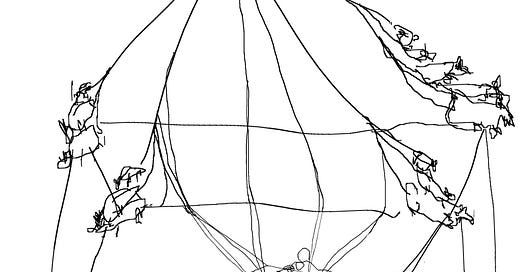Orsolya Bajusz: The Rat King (excerpt, translated by the author)
The Rat King can mostly be described by foreign concepts: vortex, emergent, cluster, and above all, a figuration. It might be representative of a certain kind of connection, a certain mode of network. It symbolizes certain social dynamics, describes possible actions and paths one might take across a territory, and is also an abstract machine structuring an embodied reality: a network of dependencies shaping a social milieu, along the vectors of subservience and spinelessness.
“If you are not a liberal, the gates of hell open, and they are going to stay open,” as a professor of his told J. during his Ph.D. This professor had procured a medical report stating that because of his arthritis, a spinal implant was improbable. Despite the ‘arthritis,’ he had the straightest spine among all J.'s professional acquaintances. Most wore the rat tail and then issued critical literature. Some staged performances where they ate kefir, peeled a banana, mopped the floor, jerked a dick, braided hair, and so on. The rat tail used to be awarded only to those who engaged in scientific production but now extended to those also involved with arts and culture. Artists used to have some kind of bionic jester hat with bioluminescent bells; nowadays, even curators were entitled to the rat tail. Galleries and arts centers functioned as gates to the coveted rat-world, for many rats humiliatingly close to the jesters.
Those who tried to get rid of the rat tail went mad. Some tore it out because they could not go on any longer and then died or became disabled. It was not possible to just amputate it; it was part of one’s nervous system, or at least the real-deal rat tail. Those with counterfeit rat tails would not have wanted to get rid of theirs anyway; they were happy to show it off at the bars of downtown Budapest. For a while, J. suspected that the tails entangled, forming a supra-entity, an emergent rat king, more than the sum of the individual parts. The extension functioned on multiple registers of subjectivity.
J. had long suspected that rat tails were knotted, that there was a supra-entity, the rat king, who was more than the sum of his parts: the emergence of qualities, attitudes, energies that would not solely come from those in tail-joint with the king. The individuals become much more rat-like together, forming a rat king, or rat kings, because it is not known where the centre, the beginning or the end is.
In rat kings, multiple levels of subjectivation were at work: individual (the tail was part of your spine), social (tugging and pulling each other), institutional (clumping together), and on a very broad macro level, the rat king shaped Hungarian society, and processes beyond Hungarian society created the rat king.
The people who were woven into the rat king did not think of subjectivity in terms of their own experiences, but thought of themselves as autonomous, measured, deliberate, guided by reason, rational, objective, even independent. The outward biting shield-heads, were to maintain the myth of the 'serious man' ideal of subjecthood, while behind their backs the tails were capturing institutions, dragging along their small, flabby discourses. All the heads were interested in preserving the status quo, as without the rat king they would have been just rats.
The existence of the rat king (a supraindividual, a collective actant) was the biggest 'fuck you' to the ethos of 'seriousness'. Yet this ideal of subjecthood was also the Rat King's main weapon and asset, and it was for this reason that he guarded the dogmas about the rationally calculating, serious subject as its most treasured possession. Those who were caught swearing, crying, raging were fair game; the rat king humiliated and tortured them to no end. All emotions were taboo beyond the shallow repertoire of decent, philistine, collected, and careful indignation, sentimentality, and pretense.
“Rational discourse” was their mania, but those who were not born to be bona fide psychopaths were never able to stay completely calm and collected during the sadistic debate-rituals of the rat kings. Staying calm and level-headed makes sense when one is in a position of authority, having to make decisions in stressful situations, but in reality, this fetishization of impassiveness resulted in the slowly reddening heads of the rat king biting each other and snapping at each other, meanwhile each head thought they were the ones able to stay serene and calm, therefore right.
Materialistic science were downright fetishised. J. knew very well that perhaps nothing in the Rat King was so despised as "esotericism", it was a real red herring in their eyes. The Hungarian folk religion (which enjoyed a revival in order to keep away the rat kings) and even naturopathic medicine was contemptuously called tantramantra, hocus-pocus, quackery, in fact because the rat kings were afraid of it. J. didn't dare tell anyone when he first felt that he was really beginning to grasp something fundamental about the Rat King: when he read that the anthropologist Bruce Grindal had gone to a funeral in Ghana and saw how, at one point in the funeral, when everyone was dancing themselves into ecstasy, the dead man got up, grabbed two drumsticks and started drumming and dancing, 'beyond the limits of empirical understanding'. J realised that whatever made the dead man get up was the same thing curving his spine, just modulated by different people and along different vectors. If he can decipher the structuring logic of the energy that resurrects the dead, he might be able to figure out how the tail curves his spine. So embarked on a quest - to study the community-building rituals of the rat king.




